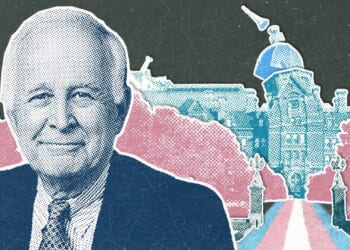It is a golden afternoon in autumn. The sun, high in the western sky, warms the soil and casts the fading harvest in hues of yellow and crimson. The field in front of Gaver Farm is full of sedans and mid-size SUVs with bumper stickers that brag of cheerleaders and Boy Scouts. Families have come by their hundreds to Mount Airy, Maryland to navigate the corn maze, feed farm animals and cut pumpkins from the vines. It is a ritual that marks the waning of the harvest and the coming of the holiday season.
With its growing “pick-your-own” agritourism operation, and herds of cattle and fields of wheat and soybeans, Gaver Farm is one of Frederick County’s agricultural gems. But Lisa Gaver, who runs the farm with her husband Mike, tells me that the joy of the harvest season has been mixed with uncertainty about the future. As it stands, the farm is along the projected route for the Maryland Piedmont Reliability Project (MPRP), a proposed high-voltage overhead transmission line that, if approved in its current form, would span roughly 70 miles through mostly rural Maryland, directly impacting hundreds of private landowners in Frederick, Carroll and Baltimore counties.
“If this is allowed to go forward,” Lisa says, “it’ll devastate our business.” The farm depends in no small part on the income that agritourism brings. Lisa worries that many guests won’t visit with the transmission lines looming overhead. She also worries that the development will affect what crops they can grow, and how they can grow them. “We’ve planned 50 years into the future, and we’re able to have our kids and grandkids working here with us for that reason,” she says. “Now we’re facing this. It’s just been so stressful.”
Inside the gates, the farm unfolds like a pop-up storybook. A boy pets a goat through a fence as the animal tugs insistently at his sleeve. A father and son shoot basketballs through peach hoops. A little girl wearing braids stands at her mother’s side, clutching her tiny green pumpkin by the stem. The place is alive, radiating with the shouts and giggles of children. “We were sold out both days this weekend,” Lisa says. “We worked all year long for that.”
***
The MPRP is at the centre of a complex web of economic, energy and other policy choices made miles and miles from Gaver Farm’s rolling fields. The surge in demand for AI-driven cloud computing has spurred a data-centre gold rush across the United States, and Northern Virginia has emerged as the world’s largest market, outpacing major global hubs like Beijing and Singapore by some metrics. Now, the energy demands of Virginia’s server farms are beginning to impact the regional electricity market. According to the Electric Power Research Institute, data centres consumed about a quarter of Virginia’s total electricity supply in 2023. “Unconstrained” demand for power in Virginia could double within the next 10 years, according to one recent policy report, with the data-centre industry being the main driver.
PJM Interconnection (PJM) is the regional transmission operator (RTO) that coordinates wholesale electricity in parts of 13 states (including Maryland and Virginia), as well as in Washington, D.C. In late 2022, the organisation noticed a spike in demand for electricity caused by the rapid development of the data centre market in Northern Virginia and advanced planning efforts to balance load growth with reliability. Since then, it has approved a slew of projects across the mid-Atlantic, representing billions of dollars in new grid investment. That includes the $424 million Maryland Piedmont Reliability Project.

PJM has said the transmission line is essential to maintaining grid reliability as the demand for electricity rises — largely due to data centres — and older power plants are retired. Public Service Enterprise Group (PSEG), the energy company developing the transmission line, similarly says the project will expand transmission capacity and strengthen the grid. “Without these updates,” spokesperson William Smith said in an email, “Maryland may face severe grid congestion, threatening affordability and reliability for ratepayers.”
Opponents, including many elected officials, say the project is not about powering Maryland. Rather, they argue that the transmission line is just an elongated “extension cord” carrying energy from Pennsylvania to the data centre hubs in the Northern Virginia suburbs, cutting through Maryland’s farms and forests along the way.
***
In July 2024, PSEG hosted its first round of informational meetings about the MPRP. That’s when Marylanders most likely to be affected say they first learned about the project. Though the energy company was considering a number of possible routes for the transmission line at that time, locals say there were already concerns about what it could mean for private landowners. There were fears that the project would cut through farms, historic properties, businesses, and conserved lands.
Jon Bisset leads River Valley Ranch, a faith-based nonprofit in the northeast portion of Carroll County. It serves more than 10,000 youth and adults annually through its summer camps, retreats, and equestrian programmes. Bisset says that the ranch was in the middle of its busiest season, with hundreds of campers on site, when administrators became aware that the transmission line could affect the camp’s fields and forests. “The pace at which this is happening… it’s just maddening,” Jon tells me as we sit at a picnic table near a stream that runs through the sun-drenched campus. “By the time we found out about it, we only had two weeks to file our appeal with PSEG about why we think this isn’t good for us. We had almost no time.”
Founded as a cowboy summer camp in 1952 by Jon’s grandfather and great uncle, the ranch is the kind of place where kids can leave the digital world behind and spend the week riding horses, tackling the ropes course and zooming over the trees on the 1,500-foot zipline. “There’s a real need,” Jon says, “for spaces where kids can unplug, be in community, and engage in activities that teach them something. We have personal, spiritual, emotional engagement with these kids through all the things that we do here, and in a lot of ways, they leave at the end of the week different than when they first arrived. This project… clear-cutting trees and installing a transmission line, it’s diametrically opposed to what we do here.”

Jon says that he’s not against AI, nor against expansion, but he does take issue with how the transmission line is being advanced. “What’s struck me about the whole thing,” he says, “is that data centres are driving all the decisions, and it should be the other way around. It just seems like we’re getting the cart before the horse and destroying a lot of property in the process.”
“My family doesn’t own this land,” Jon tells me, “but we’ve always understood ourselves to be stewards of this land. We’re using what belongs to God for His glory. We feel we have a moral obligation. That’s why we’re standing up to this.”
PSEG announced its proposed route in October 2024. Jon tells me if the project advances in its current form, it’ll cut through 17 acres at River Valley Ranch. He shows me the place, pointing from a field into a dense forest. “There’ll be a clear cut path right through there.”
***
In Maryland, construction of a high-voltage transmission line generally requires a Certificate of Public Convenience and Necessity (CPCN), a mandatory permit issued by the state’s Public Service Commission (PSC). The process includes a multi-step review, in which the applicant must notify affected local governments, provide opportunities for public comment, and submit a detailed application describing the project’s purpose, alternative routes, and environmental and socioeconomic impacts. If the CPCN is granted, then PSEG may, if necessary, initiate eminent domain proceedings to acquire land or easement rights from property owners unwilling to reach a voluntary agreement.
PSEG filed its CPCN application in late December 2024. Then, in March 2025, the Power Plant Research Program (PPRP), which acts as coordinator and technical reviewer for proposed transmission projects, said in a letter to PSC that while PSEG’s application did include a description of the MPRP along with an explanation of its purpose, it lacked adequate information about alternative project routes and specific environmental and socioeconomic impacts. “This is especially important for this Project given its significant length and impacts to land uses, which will be necessary for its construction and operation,” the letter said. “Without field-based information, [the programme] cannot fully evaluate the Project’s impacts to Maryland’s socioeconomic and natural resources.”
In April 2025, PSEG filed the first of three lawsuits (as of this writing) in the US District Court for the District of Maryland, seeking temporary access to private properties for the purpose of performing the field studies. Though the developer offered landowners $1,000 to allow surveyors to enter properties for tests, a PSEG spokesperson said, more than 300 declined. Legal action was appropriate, the company argued, under a Maryland law that allows surveyors acting on behalf of “any body politic or corporate having the power of eminent domain” to apply to “a law court of the county where the property, or any part of it, is located” for an order allowing entry in certain circumstances. In the first two lawsuits, a federal judge granted preliminary injunction requests allowing PSEG to access hundreds of named properties to conduct surveys, so long as the company provides 24-hours notice to landowners. The third lawsuit is still pending.
Opponents to the transmission line say the ruling sets a dangerous precedent. They argue that, because the PSC has not yet determined whether the project is needed in Maryland, PSEG does not have statutory authority to enter private property. Stop MPRP, Inc., a non-profit membership organisation that says its aim is to balance technological advancements with agricultural, environmental and housing preservation, stated in a post on its website: “This ruling forces landowners — many of whom have farmed and stewarded this land for generations — to allow private utility contractors on their property against their will. This ruling subjects hardworking Americans to strangers having unfettered access to their property… This is not just a local issue.”
“Opponents to the transmission line say the ruling sets a dangerous precedent.”
PSEG has already started conducting land surveys on some of the properties to which it was granted temporary access through prior rulings. Even so, some of the impacted landowners have sought to overturn the federal district court ruling, saying that the decision has “sweeping provisions and consequences” that will affect them for the “months or years” during which Maryland Regulators are considering the power-line proposal. A brief filed in the 4th US Circuit Court of Appeals argues that, in granting PSEG’s request for a preliminary injunction, the district court “ignored substantial damage to Appellants, whose property rights will be trampled without even the promise of future just compensation”.
According to a procedural calendar released by the Public Service Commission, PSEG will be expected to file updated analysis including some field studies by March 2026. That will be followed by a series of public hearings and other procedural steps. The PSC isn’t expected to issue a final decision about whether to approve PSEG’s application for a Certificate of Public Convenience and Necessity for the project until March 2027 at the earliest.
***
Betsy McFarland and her husband Michael live at the end of a narrowing two-lane road in Frederick County’s Adamstown community. As I drive there, I spot a sign hanging from a neighbour’s garden fence that says “STOP MPRP: No Eminent Domain For Corporate Gain”. There are a dozen or so more signs posted in front of houses throughout the neighbourhood.
From the McFarlands’ back porch, you can look out beyond the sycamores and oak trees and see Sugarloaf Mountain in the distance. Nearer, Bennett Creek hugs the edge of the forest, its waters flowing toward the flaxen fields of a neighbouring farm and then far beyond it to the Monocacy River.
“Right there is where the powerline would go,” Betsy tells me, pointing into the woods very near to the spot where we’re standing. “It would run right between here and Bennett Creek.” The line, she says, would require an easement 150 feet wide, and could come as close to 50 feet of their house. “We would never want to leave, but if the power line comes, we feel like we won’t be able to stay.”
Betsy recalls a man who spoke at one of the earliest meetings. He said he’d moved with his family out West and was working on selling their house back in Maryland. He had a buyer, he told the crowd, but after the project was announced, the deal fell through. “That just sent all of us into a panic,” Betsy says. “For us, this property is our biggest investment.”
Betsy and Michael have been in this house for 20 years. They moved here from a suburb of Washington, D.C. because they wanted to spend more time in nature. “We fell in love with it,” Betsy almost sighs. “It’s like a slice of heaven.” “In the spring,” she says, “I can sit inside and hear baby eagles out here chirping. It’s just really special.”

But in the last year, Betsy laments, the place has started to feel like a paradise interrupted. There have been no visits from surveyors yet, but Betsy understands that they’re coming. “It feels like they’ve gotten permission to come on our land to get information to take our land,” she says, “like they’re coming here to gather more ammo to use against us.”
When I ask what the stakes are for her, Betsy turns contemplative. “If we win,” she says, “we get to keep what’s already ours.” She pauses to think before she goes on. “To be honest, if I were fighting this by myself, I don’t think I could do it. We really need each other. We all get frustrated, we all get overwhelmed, but we just try to lift each other up and keep going.”
Betsy is an active member of citizen-led group Stop MPRP, which has joined forces with farm and conservation organisations like the Maryland Farm Bureau, Preservation Maryland, and the Gunpowder Valley Conservancy in the push against the green-field route. Betsy says that the local opposition effort has sometimes felt like a second job, but she says it’s worth it.
***
As the MPRP has continued to make its way through Maryland’s regulatory process, it has been met with scepticism from state and local officials. Maryland Governor Wes Moore has shared what he calls “grave concerns” about the way the MPRP has been advanced. In a public statement released in late 2024, he said that Maryland “need[s] sustainable and cost-effective infrastructure to ensure the reliability of our grid and build the economy of the future in our state. But the approach must be one that puts people first”. Earlier this year, Moore was among nine governors who signed an open letter to PJM voicing frustration about reliability and the rising cost of electricity, alongside misgivings about the company’s leadership.
A number of Maryland state legislators have likewise expressed disapproval of the MPRP, and administrative bodies in all three affected counties — Carroll, Baltimore, and Frederick — have passed resolutions formalising their oppositions to the development. Meanwhile, the Carroll County Government, Baltimore County, and Frederick County’s Office of the County Attorney have filed petitions to intervene as the Maryland Public Service Commission considers whether to grant PSEG’s request for a Certificate of Public Convenience and Necessity.
Carroll County has been especially staunch in its opposition. The Carroll County Board of Commissioners filed an amicus brief with the 4th US Circuit Court of Appeals on behalf of landowners. Then, in a joint letter to President Trump, county commissioners, along with Carroll County’s Delegation to the Maryland General Assembly, requested that the administration support alternatives to the MPRP, including the modernisation and optimisation of existing infrastructure, investment in distributed energy systems, and short-term energy generation for data centres including fossil-fuel based generation and small modular reactors to address immediate needs.

“I don’t want to be like so many people who only care about something that’s in their own backyard,” Commissioner Kenneth Kiler tells me on a Monday morning in his office in Westminster. “I went to high school here. My kids went to high school here. We don’t know everybody, but we know a lot of people, and a lot of people are going to be affected by this.” Commissioner Kiler, who serves as President of Carroll County’s Board of Commissioners, says that folks here “really work together”. He gestures around him as though the people he’s talking about are standing in the room with us. “There were people on the earlier routes who were not on the final route,” he says, “and now they’re fighting just as hard, because they care about their friends and neighbours.”
He tells me that he is strongly against the MPRP. “It doesn’t benefit us whatsoever,” he says. “It just runs through us. And that’s a shame.” And then there’s the issue of trust. “I think everybody in Carroll County is sceptical about this and they need some reassurance,” he says. “But instead of reassurance, with the way they’ve approached this, I think they’ve almost affirmed some of that scepticism.”
***
Back in Frederick County, Betsy introduces me to her neighbours, Matt and Zana Moran. The couple live just down the road from the McFarlands in a house they built themselves with materials they sourced from the land. “It’s truly amazing,” Matt tells me, “just one tree provided a quarter of the lumber we needed for the house.”
Matt’s father Frank bought this piece of property — some 40 acres — in the Seventies. Frank had moved around a lot as a boy, as his own father had served in the Marine Corps, and so he was looking or a green space to settle into and grow deep roots. When he found this place, he and his wife Terri built their home themselves. Their children, Matt and his brother Pat, used to wander for miles through the green space around the property.
When Matt and Pat were grown, Frank invited them to build their own homes here — he wanted this to be a place where they could raise their own families. Now, there are three generations here, joined together in this hamlet.
If the transmission lines are built along the planned route, they could pass within 120 feet of Frank’s house. Matt and Zana tell me that, because the house was so closely designed to coexist with the seasons of the forest, the clear-cutting required for the project could make the place unliveable.
“The clear-cutting required for the project could make the place unliveable.”
Zana, who is quiet and thoughtful, says that she’s heartbroken for Matt’s parents. “They were really living off the land as much as they could. I’m just devastated for them and for people like them. This goes against their entire moral fibre, their entire life’s philosophy.”
“There’s a certain autonomy that you ought to be able to exercise on your own land,” Matt says. “There was a time when we never worried about closing gates, or putting up signs, or anything like that. But this has changed our neighbourhood. It looks less welcoming. And it is less welcoming. Because we don’t want this here.”
Before I leave, we take a walk around the property with the Morans’ black dog. “You know,” Zana reflects, “there is value in new technology, and I see that, but that doesn’t mean the value of everything else is negligible. I think we need to slow down. We need to more reasonably make decisions, and really consider our values. What are we willing to give up? And what do we expect in return?”

















